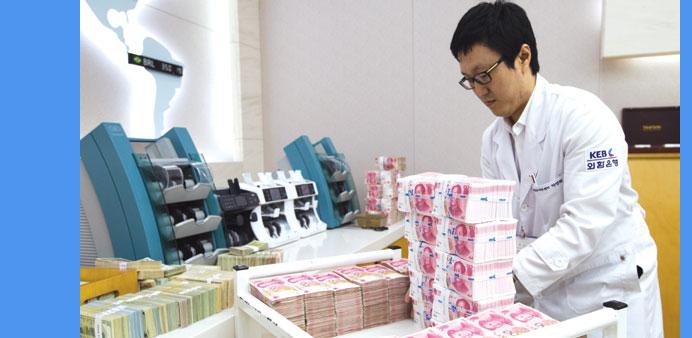An employee arranges yuan banknotes at the Korea Exchange Bank headquarters in Seoul. China will improve the exchange rate’s mechanism and expand the scale of yuan trade settlement.
Bloomberg/Hong Kong
China will allow the yuan to trade in a wider range against the dollar, the State Council said, without giving a timing or scope for the potential adjustment.
Flexibility will be increased, the cabinet said in a statement Friday that focuses on supporting the nation’s trade after an index of factory activity fell to a 15-month low. The exchange rate will be kept at a basically stable level, the State Council said. The yuan traded in Hong Kong fell the most in almost three weeks on Friday, and its one-month implied volatility surged to the highest since July 14.
The onshore yuan in Shanghai, where moves are limited to 2% on either side of a daily fixing, weakened the least in emerging markets this year as the People’s Bank of China seeks global reserve-currency status at an IMF review in November. While a wider trading range would allow market forces a bigger role, it could provide room for depreciation and help exports.
“The State Council is implying that the PBoC should widen the trading band,” said Andy Ji, a Singapore-based strategist at the Commonwealth Bank of Australia. “The authorities may allow the yuan to weaken to boost China’s exports, if the PBoC reduces its intervention in the existing band.”
The offshore yuan, which trades freely in Hong Kong, fell 0.14% Friday and 0.15% for the week to 6.2227 a dollar as of 5:46pm local time, according to data compiled by Bloomberg. The day’s drop was the biggest since July 6. The onshore rate, which has stayed within 0.35% of 6.2 against the greenback since the end of March as China pushes its reserve-status bid, was unchanged and closed at 6.2095.
The trading band was last expanded in March 2014 from 1%, and before that doubled from 0.5% in April 2012. It was 0.3% before an adjustment in May 2007.
The PBoC could raise the limit within a month, said Zhu Haibin, Hong Kong-based chief China economist at JPMorgan Chase & Co. It’s rare for the State Council to mention the yuan’s trading range, and the PBoC is likely to widen the band to 3%, he added. The International Monetary Fund’s mission to China said in a statement in May that, although the yuan is no longer undervalued, it needs to be more flexible. China should limit intervention to avoid disorderly market conditions or excessive volatility, the mission said.
Of 24 analysts surveyed by Bloomberg in June, 14 forecast the yuan’s trading band will be widened in 2015, up from eight out of 22 in a January poll. In a separate survey in the June 18-24 period, 11 of 16 economists predicted the IMF will add the yuan to its Special Drawing Rights this year.
China will improve the exchange rate’s mechanism and expand the scale of yuan trade settlement, the State Council said Friday. The country will study the starting of more hedging tools for companies to deal with currency risks.
“It doesn’t mean yuan-band widening is happening soon, but that the PBoC can make a move since the State Council has cleared it,” said Li Liuyang, a Shanghai-based strategist at Bank of Tokyo-Mitsubishi UFJ Ltd “Yuan depreciation is positive for domestic demand as well as exports.”



